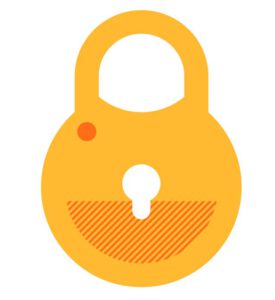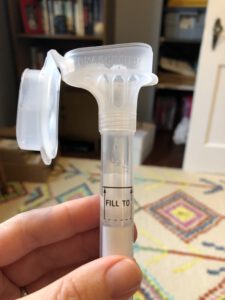By Amanda McCorquodale
Raising children often feels like watching my own little science experiment on the effects of nature versus nurture. While all the ingredients in the pantry were the same, it is clear that my daughters were baked with slightly different recipes.

Amanda’s twin girls.
One has thick brown hair with brown eyes and the other thin blond hair and blue eyes. One gets intensely high fevers for just 24 hours while sick. The other will be mildly infirm for weeks before clearing a cold. One likes a scalding hot bath. Her sister can only tolerate lukewarm temperatures.
Getting Started with 23andMe
Our household presented almost the exact environment and lifestyle for both girls, yet their genes were taking them down different, often opposite, paths. While I conjectured who received which grandparent’s sweet tooth or hot temper, I became intrigued by a genetic test like 23andMe that could track some of these genetic traits. In reality, we are all so genetically similar— we are each about 99.5 percent identical — yet that very tiny difference is enough to make us each unique, even within my own family.
But trying out 23andMe was about more than just curiosity, I wanted to learn about my health too. Having just turned 40, I was curious to know more about what exactly was printed on my own recipe card, and how much of that I may have passed on to my daughters.

Registration, Considerations, and Consent
The small box containing 23andMe’s collection kit came quickly in the mail. After taking it out of the plastic wrap and sliding off the cardboard sleeve, the first step was to register the kit online to link my account to the actual barcode on the test tube inside.
Once I verified my email address, the web site ran through a list of choices I would be able to opt-in and out of, such as:

- Whether to have my saliva sample stored or discarded after it has been analyzed
- Which of the health reports — on conditions like Late-Onset Alzheimer’s Disease or Parkinson’s disease — I will view and/or opt-in to view
- When and with which of my 23andMe DNA Relatives I share my information
- To give or decline consent for 23andMe Research (more on this below)
- Although not part of the registration process, it’s clear that if I change my mind about using 23andMe, I have the option of deleting my 23andMe account and my data at any time
Privacy and Consent
The registration site then presented me with a list of protections. 23andMe also provides additional information on its website about how my data would be kept private; these details are further covered in their Privacy Statement and Terms of Service.
There’s also a helpful link on all many of these steps for registering your kit. For example, I was assured 23andMe will never share my data with any public databases, insurance companies, employers, or law enforcement or regulatory authorities unless required by law. 23andMe also asserts that they have a Church and State-type separation in how information is handled. In other words, personally identifying information is stored separately from genetic data.

As the registration proceeded, 23andMe also prompted me to take a moment and consider all the possible implications of DNA testing. Essentially, you might find out something unexpected. For instance, I might learn that someone I thought was related to me isn’t actually a biological relative, or I might find out something else — a health risk for instance — that causes me anxiety. Anyone considering doing a DNA test will likely have thought about these possibilities at some point, but it was worth giving these implications more thought before sending my sample off.
Participating in Research
Going back to the question about research consent, I was then asked if I want to participate in 23andMe’s research programs. While a DNA test is largely about uncovering more about oneself, it was interesting to think about how that information could also advance research. 23andMe explains what consenting to participate in research means. There is also a detailed explanation about the meaning of “individual data sharing.” There even is a heads up that if I decide to participate in research, I might be recontacted about specific research projects.
As I finished the process, 23andMe reviews which programs I have consented and gives me opportunities to contact a 23andMe representative to ask more questions. If later on, I change my mind about participating in research, I can remove my consent without changing my access to my results. In the end, the registration process, including considering the choices and consequences of those choices, took me about 15 minutes.
What the Sample Process was Like

Just a little spit.
Giving your sample is pretty straight forward, but as it turns out there’s actually an art to spitting into a tube. 23andMe’s kit consists of a test tube topped with a larger mouth funnel for ease of spitting, but a half teaspoon of saliva doesn’t seem like a lot until you actually sit down and do the deed.
23andMe offers up some helpful suggestions and warns that you shouldn’t have eaten or drunk anything within a half-hour of giving your sample. If a case of sudden dry mouth occurs (as it did for me), 23andMe has a list of suggestions to get the saliva flowing again. (I found it particularly helpful to imagine the taste and smell of tart foods like lemons.)
In the end, it took me about 20 minutes to generate the required sample. Once collected, I snapped the top of the funnel closed, which released a stabilizing liquid into the tube. I then unscrewed the funnel top and replaced it with the provided blue cap before placing the tube in the provided specimen bag. After packaging the kit with the provided mailing label, I placed the box in the mail.
A few days later I received an email confirming that my sample arrived at the lab. This began the toughest part of the process, waiting on my results.
Stay tuned for Part II to learn what it was like to get a peek into my own DNA and get my Ancestry + Health Service reports.
Amanda McCorquodale is a freelance writer. Her work has appeared in Gourmet, Miami Magazine and Mental Floss. She previously worked as an associate editor at the Huffington Post and as an Arts and Culture Editor at the Miami New Times. She lives in New York with her family.